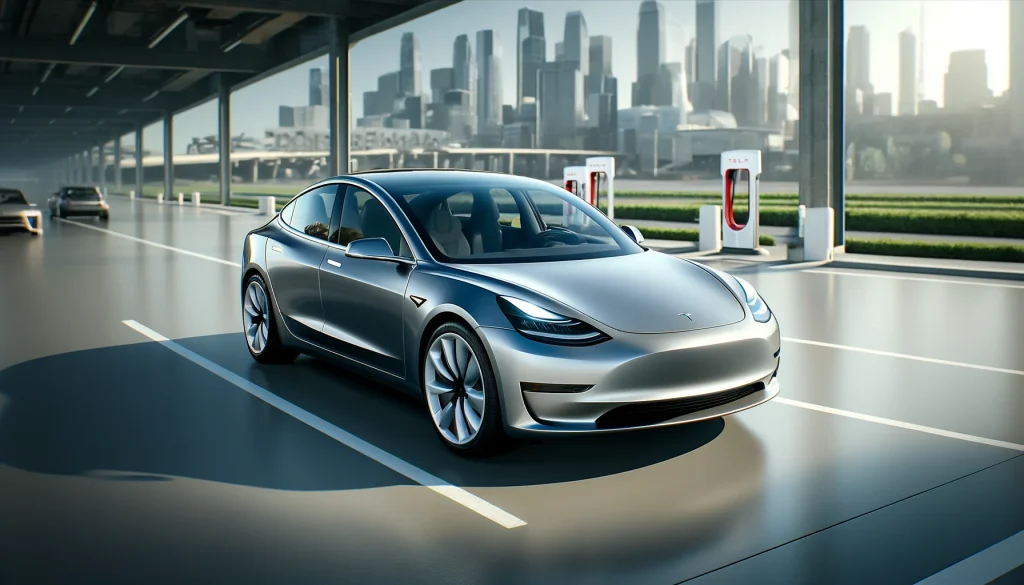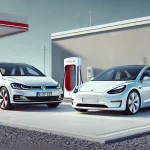The Tesla Model 3 has become the benchmark for electric vehicles (EVs) globally, dominating sales charts and reshaping consumer expectations for electric mobility. With its sleek design, impressive performance, and accessible pricing, the Model 3 has made EVs mainstream. In this article, we will explore the key features, advantages, and drawbacks of the Tesla Model 3 and compare it to other Tesla models and its closest competitors.
Overview of Tesla Model 3
Introduced in 2017, the Tesla Model 3 is a compact electric sedan designed to offer a more affordable entry point into Tesla’s lineup without sacrificing performance or innovation. It is available in several configurations, including the Standard Range Plus, Long Range, and Performance models, catering to different customer needs and budgets.
The Model 3’s minimalist interior design is a standout feature, with a single 15-inch touchscreen serving as the central control hub for nearly all vehicle functions. The car boasts advanced technology, including Tesla’s Autopilot, over-the-air software updates, and a robust Supercharger network for convenient long-distance travel.
Performance and Range
One of the most appealing aspects of the Tesla Model 3 is its performance. The Standard Range Plus model offers a 0-60 mph acceleration time of 5.8 seconds and a range of up to 272 miles. The Long Range model increases the range to 358 miles and achieves a faster 0-60 mph time of 4.2 seconds, making it ideal for those who prioritize both distance and speed. The Performance model, designed for enthusiasts, delivers a 0-60 mph time of just 3.1 seconds, along with track-ready capabilities.
In addition to its speed and range, the Model 3 features excellent handling and a low center of gravity, thanks to its battery placement beneath the floor. This contributes to a smooth and stable ride, whether navigating city streets or cruising on the highway.
Charging and Infrastructure
The Model 3 benefits from Tesla’s extensive Supercharger network, which provides fast and reliable charging for long trips. With the ability to add up to 175 miles of range in just 15 minutes at a Supercharger, the Model 3 alleviates much of the range anxiety typically associated with EVs. Additionally, the car supports Level 2 home charging, which is convenient for daily use.
However, while Tesla’s proprietary Supercharger network is a significant advantage, it limits the use of third-party fast chargers, which can be more readily available in some regions. This is an important consideration for potential buyers who live in areas with fewer Tesla-specific charging options.
Advantages of the Tesla Model 3
1. Affordability: The Model 3 is Tesla’s most affordable vehicle, making it accessible to a broader audience. Its competitive pricing, combined with low operating costs, enhances its appeal.
2. Advanced Technology: Tesla’s Autopilot and Full Self-Driving (FSD) capabilities set the Model 3 apart from many competitors, offering semi-autonomous driving features that improve safety and convenience.
3. Performance: With quick acceleration, agile handling, and impressive range, the Model 3 delivers a thrilling driving experience while remaining practical for daily use.
4. Over-the-Air Updates: Tesla’s ability to improve the vehicle’s performance and add features through software updates ensures that the Model 3 remains cutting-edge long after purchase.
Drawbacks of the Tesla Model 3
1. Minimalist Interior: While some appreciate the clean design, others may find the lack of physical controls and reliance on the touchscreen interface to be inconvenient or distracting.
2. Build Quality: Some owners have reported issues with fit and finish, such as panel gaps and paint quality, which may not align with expectations for a premium vehicle.
3. Charging Limitations: Although Tesla’s Supercharger network is extensive, the proprietary nature of its charging system can limit compatibility with third-party fast chargers.
Comparison with Other Tesla Models
The Model 3 sits below the Model S and Model X in Tesla’s lineup in terms of price and luxury. The Model S offers greater range, faster performance, and a more premium interior, but at a significantly higher cost. The Model X, as an SUV, provides more space and unique features like Falcon Wing doors, making it better suited for families or those needing extra cargo capacity.
Compared to the Model Y, which shares many components with the Model 3, the Model Y offers more interior space and an optional third row, making it a more versatile choice for families. However, the Model Y comes at a slightly higher price point, which may sway budget-conscious buyers toward the Model 3.
Comparison with Competitors
In the compact EV segment, the Tesla Model 3 faces competition from vehicles such as the Polestar 2, Chevrolet Bolt EUV, Hyundai Ioniq 5, and Ford Mustang Mach-E. While these models offer unique features and competitive pricing, the Model 3’s combination of range, performance, and access to Tesla’s ecosystem gives it a distinct edge.
The Polestar 2 rivals the Model 3 in terms of interior quality and design, while the Hyundai Ioniq 5 offers advanced technology and fast-charging capabilities. However, Tesla’s superior software, Autopilot system, and widespread Supercharger network often tip the scales in its favor for many buyers.
Conclusion
The Tesla Model 3 has earned its reputation as the world’s best-selling electric vehicle by combining affordability, performance, and cutting-edge technology. While it has its drawbacks, such as build quality concerns and charging limitations, its advantages far outweigh these issues for most buyers. Whether you’re new to EVs or an experienced driver looking to upgrade, the Model 3 offers a compelling package that continues to set the standard in the EV market. As Tesla continues to innovate, the Model 3 remains a top choice for those seeking a reliable, high-performing, and accessible electric car.



The Tesla Model 3 has truly set the standard for electric vehicles
affordable & fast! great 1st ev!!! tesla rocks 🤘! Mask rules!
m3 is popular ev 👍. cheap-ish & fast . not bad.
tech is cool 👍 some ppl say it’s cheap… but im not beleave
model 3 so popular, but is it worth it… onle supercharg is bad, i read what this break batteries
Idk man, Ive had this ride for a couple years now and its been chill!😎
model 3 pricey but hella fun 👍👍👍👍
best ev ever no cap👍